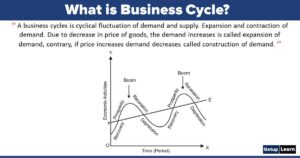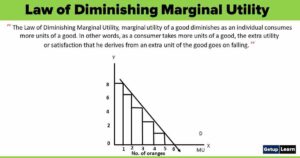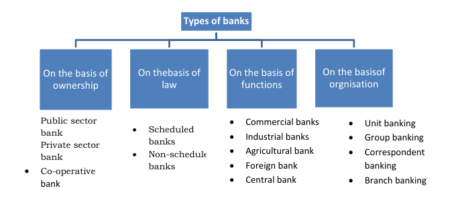Table of Contents
What is Consumer Surplus?
Consumers surplus is the economic gain accruing to a consumer (or consumers) when they engage in trade. The gain is the difference between the price they are willing to pay and the actual price. Consumer surplus is the difference between the sum which measures the total utility and that which measures the total exchange value.

Table of Contents
In day-to-day consumption, there are many such commodities from whose use the consumer obtains much more utility, as compared to its price, i.e. the sacrifice of utility made in the form of price. For example, we get a postcard for 50 paise only, but we derive much more utility from it, say equal to 100 paise.
Then, we have a feeling of a surplus of 100 – 50 = 50 paisa, which is the consumer surplus. In other words, the difference between the expected price which we may be ready to pay for a commodity and the actual price paid is known as consumer surplus
Definition of Consumer Surplus
[su_quote cite=”Prof. J. K. Mehta”]Consumer surplus obtained by a person from a commodity is the difference between the satisfaction which he derives from it and which he forgoes in order to procure that commodity.[/su_quote]
[su_quote cite=”Prof. Marshall”]The excess of price which one is willing to pay rather than go without the thing over that which he actually does pays, is the economic measure of this surplus satisfaction. It may be called the consumer’s surplus.[/su_quote]
[su_quote cite=”Prof. Taussig”]Consumer surplus is the difference between the sum which measures the total utility and that which measures total exchange value.[/su_quote]
Concept of Consumer Surplus
The concept of consumer surplus is based on the law of diminishing marginal utility. We know that utility obtained by the consumer from the consumption of the first unit of the commodity is high, but as he consumes subsequent units of the commodity, the utility derived from these units goes on decreasing, gradually.
But, the consumer pays an equal price for all the units. The consumer consumes various units of the commodity up to that level, at which the marginal utility of the unit of the commodity and the price of the commodity become equal. In this process of consumption, the utility of starting units of the commodity is much more than the price.
Hence, the consumer derives surplus from all units preceding the last unit. This feeling of the consumer is the consumer surplus. Hence, it is evident that consumer surplus is based on the tendency of the utility.
Illustration: Suppose a person purchases oranges in the market. The normal price of orange in the market is 50 paisa. In the following table, the utility derived from various units of orange, i.e. the price which the consumer is willing to pay, the actual market price and the difference between both, i.e. consumer surplus has been shown:
Utility Obtained from Oranges
| Units of orange | Utility to be derived from the orange (In paisa) | Market Price (In paisa) | Consumer’s surplus (in paisa) |
| 1 | 250 | 50 | 250-50= 200 |
| 2 | 200 | 50 | 200-50= 150 |
| 3 | 150 | 50 | 150-50= 100 |
| 4 | 120 | 50 | 120-50= 70 |
| 5 | 100 | 50 | 100-50= 50 |
| 6 | 70 | 50 | 70-50= 20 |
| 7 | 50 | 50 | 50-50= 00 |
| Total | 940 | 350 | 940-350= 590 |
It is evident from the table that when the consumer is willing to purchase the first unit of orange, then he is ready to pay up to Rs. 2.50, but he has to pay only 50 paise for that. Hence, he has a saving equal to 200 paise. Similarly, he also gets different savings from second to sixth units. For the seventh unit, the utility derived is the same as is the market price. Hence, for this unit, the consumer surplus is zero.
Now, we may say that the consumer gets utility equal to 940 paise from seven units of orange and he is ready to pay this much of price for these. But, the market value of these seven units of orange is equal to 350 paise. Hence, he has the saving equal to the difference between the two, i.e. of 590 paise. This illustration may be explained by diagram 1 on the next page.
In the diagram, Units of orange have been shown on the OX axis and the utility obtained from the commodity and price paid have been shown on the OY axis. OP (50 paise) is the market price of orange. The rectangles drawn above OP show the consumer surplus.
In the above diagram, the total utility obtained from various units of a commodity has been shown by O.Q.E.A. For obtaining this commodity, the price actually paid by the consumer is equal to O.Q.E.P., consumer surplus, the difference between these two is equal to A.P.E.
Assumptions of Consumer Surplus
Following are the assumptions of consumer surplus:
- Utility Is Measurable
- Application of Law of Diminishing Marginal Utility
- Independent Utility of Commodity
- Marginal Utility of Money Remains Constant
- Lack of Substitute Goods
- Other Things Remaining the Same
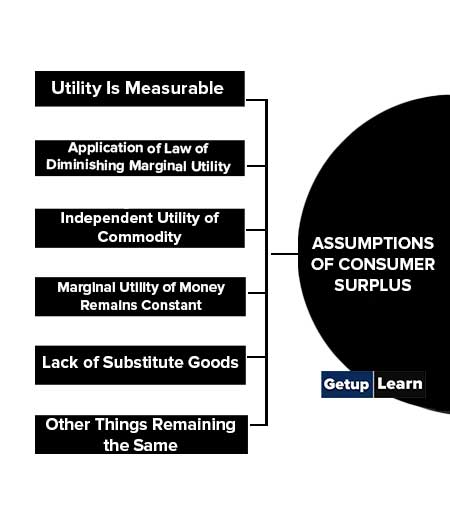
Utility Is Measurable
Utility Is Measurable: Prof. Marshall has regarded money as the basis to measure utility because the price of any commodity is paid due to the power in the commodity to provide utility.
Application of Law of Diminishing Marginal Utility
Application of Law of Diminishing Marginal Utility: Prof. Marshall has regarded the law of diminishing marginal utility as the basis of consumer surplus.
Independent Utility of Commodity
Independent Utility of Commodity: This concept is based on the assumption that each commodity is independent of the other, meaning thereby that the consumption of a commodity is not affected by the consumption of another commodity.
Marginal Utility of Money Remains Constant
The Marginal Utility of Money remains constant: The concept of consumer surplus assumes that the marginal utility of the money is constant, irrespective of the quantity of money possessed by him.
Lack of Substitute Goods
Lack of Substitute goods: No commodity is having a substitute commodity. If it is at all the substitute commodity, it should also be assumed as the main commodity.
Other Things Remaining the Same
Other things remain the same: Changes in incomes, tastes, nature and fashion of the consumers offset the effects of each other, for measuring the consumer’s surplus. Hence, it is assumed that these differences and variations have no effect on consumer surplus. Measurement of Consumer’s Surplus:
Consumer’s Surplus = Price willing to pay-Actual price
Or Marginal utility (MU)- Market price (MP)
Difficulties in Measurement of Consumer Surplus
The above analysis shows that the measurement of consumer surplus is easy. But it is not so, in practice, this principle has been bitterly criticized by various economists.
Following difficulties arise in the measurement of consumer surplus:
- Utility is not Measurable
- Marginal Utility of Money does not Remain Constant
- Consumer Surplus from Necessities is Infinite
- Consumer Surplus for Prestigious Goods is Infinite
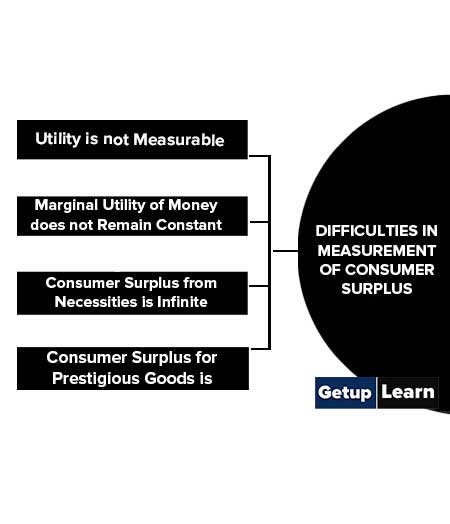
Utility is not Measurable
The utility is a subjective and psychological concept. Hence, it cannot be measured in terms of money. A consumer’s surplus is the difference between the utility of any commodity and the utility sacrificed. When we can not correctly measure the utility, we cannot measure the consumer’s surplus also.
Marginal Utility of Money does not Remain Constant
The correct measurement of consumer surplus depends upon the fact that the marginal utility of money should remain constant. But in reality, it does not happen so, because as the consumer goes on purchasing more and more units of the commodity, the quantity of money with him goes on decreasing, due to which the marginal utility of money starts increasing. In such conditions, it becomes difficult to measure consumer surplus.
Consumer Surplus from Necessities is Infinite
The intensity of necessities is very high. A consumer gets ready to pay, for whatsoever is demanded the necessities, rather than being deprived of them. In such conditions, consumer surplus will be quite uncertain and infinite.
Consumer Surplus for Prestigious Goods is Infinite
Consumer surplus is not assessable in respect of prestigious goods, like diamonds, ancient sculptures, artistic goods etc. People feel their utility only on their prices being high. If these things become cheap, they do not remain prestigious and their utility goes down. Hence, consumer surplus for such goods is also uncertain and infinite, which can not be measured easily.
Criticisms of Consumer Surplus
Although the concept of consumer surplus has acquired a significant place in welfare economics, the economists, have criticized it, on the following grounds:
- This Law is Imaginary and Impractical
- Unrealistic Assumption
- Consumer Surplus does not Remain Constant
- Consumer Surplus from Necessities and Prestigious Goods Unrealistic
- Correct Measurement of Consumer Surplus is Difficult
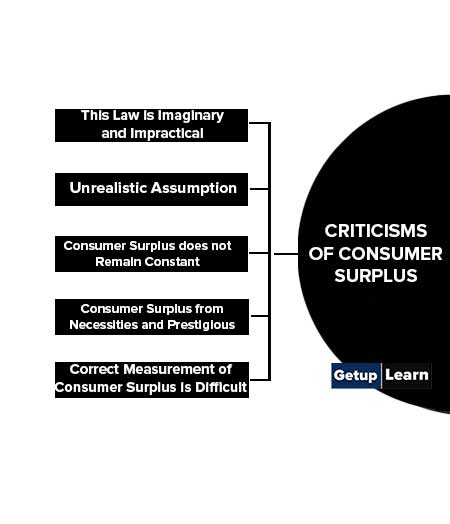
This Law is Imaginary and Impractical
This law is imaginary and misleading, Prof. Nickelson has said What is the benefit of saying that an income of 100 pounds in London is equal to 1000 pounds in Africa. Truly, consumer surplus states like that.
Unrealistic Assumption
The assumption of consumer surplus is unrealistic and unscientific. So, the critics have observed that:
- The utility is a psychological concept, and hence it cannot be measured.
- The marginal utility of money does not remain constant. As the consumer goes on purchasing more and more units of some commodity, the quantity of money with him goes on decreasing and as a result, the marginal utility of money goes on increasing.
- The utility of the commodities is not completely independent from each other and is mutually dependent because the consumer does not consume only one commodity and rather consumes several commodities.
The tastes of the consumers and fashion etc. are prone to change according to the time and circumstances.
Consumer Surplus does not Remain Constant
The critics feel that the consumer’s surplus is prone to change. Hence, with an increase in the price of the commodity the consumer, his tastes, fashion and habits etc. also, change fast in this changing age. The assumption of consumer surplus being constant is not proper.
Consumer Surplus from Necessities and Prestigious Goods Unrealistic
The critics feel that the consumer’s surplus in respect of necessities and prestigious goods is uncertain and infinite. The consumer may be ready to sacrifice quite high for any life-saving commodity. He may sacrifice everything for that. In such conditions, the consumer’s surplus obtained from such commodities is not measurable.
Correct Measurement of Consumer Surplus is Difficult
Consumer surplus can not be measured correctly. Because:
- The utility is a psychological and personal concept.
- The marginal utility of money does not remain constant.
- Consumers differ in tastes and sensitiveness.
- Consumers are not of equal economic status. Besides, due to the presence of substitutes also, consumer surplus cannot be measured. Hence it is not possible to correctly measure the consumer’s surplus, the practical importance of this principle remains quite limited.
What is the meaning of consumer surplus?
Excess of the price which one is willing to pay rather than go without the thing over that which he actually does pay is the economic measure of this surplus satisfaction. It may be called the consumer’s surplus.
Which best describes consumer surplus?
A consumer‘s surplus is the excess of price which a consumer is willing to pay rather than to go without it over that which he actually does pay or it is the difference between the marginal utility of the commodity and price.


